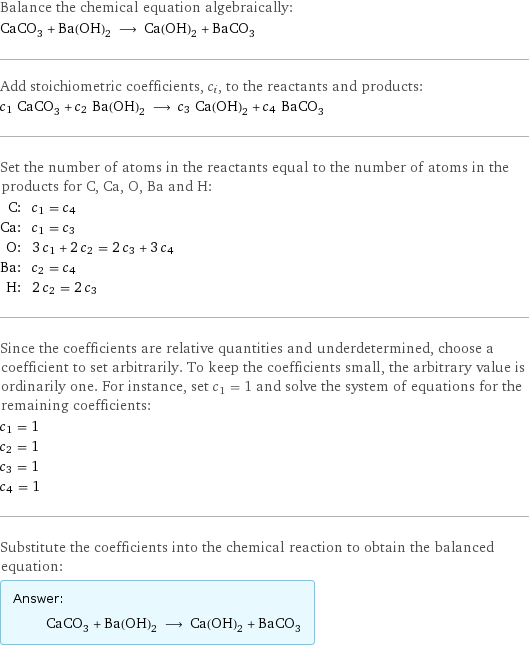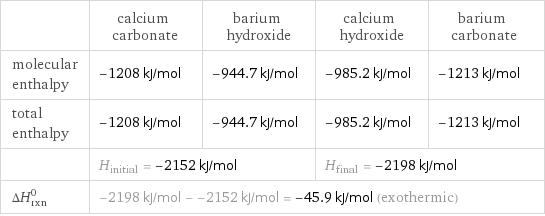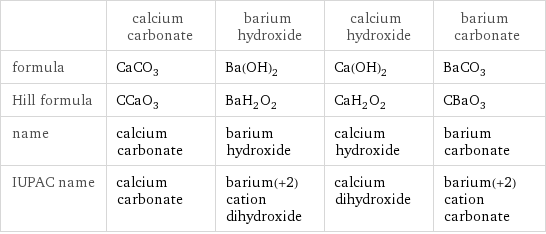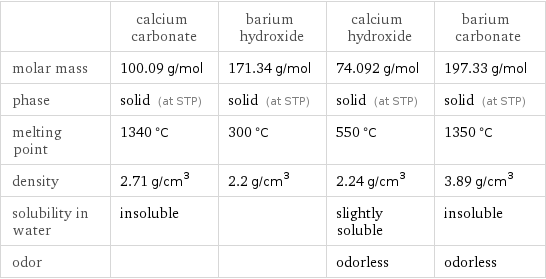Input interpretation

CaCO_3 calcium carbonate + Ba(OH)_2 barium hydroxide ⟶ Ca(OH)_2 calcium hydroxide + BaCO_3 barium carbonate
Balanced equation

Balance the chemical equation algebraically: CaCO_3 + Ba(OH)_2 ⟶ Ca(OH)_2 + BaCO_3 Add stoichiometric coefficients, c_i, to the reactants and products: c_1 CaCO_3 + c_2 Ba(OH)_2 ⟶ c_3 Ca(OH)_2 + c_4 BaCO_3 Set the number of atoms in the reactants equal to the number of atoms in the products for C, Ca, O, Ba and H: C: | c_1 = c_4 Ca: | c_1 = c_3 O: | 3 c_1 + 2 c_2 = 2 c_3 + 3 c_4 Ba: | c_2 = c_4 H: | 2 c_2 = 2 c_3 Since the coefficients are relative quantities and underdetermined, choose a coefficient to set arbitrarily. To keep the coefficients small, the arbitrary value is ordinarily one. For instance, set c_1 = 1 and solve the system of equations for the remaining coefficients: c_1 = 1 c_2 = 1 c_3 = 1 c_4 = 1 Substitute the coefficients into the chemical reaction to obtain the balanced equation: Answer: | | CaCO_3 + Ba(OH)_2 ⟶ Ca(OH)_2 + BaCO_3
Structures

+ ⟶ +
Names

calcium carbonate + barium hydroxide ⟶ calcium hydroxide + barium carbonate
Reaction thermodynamics
Enthalpy

| calcium carbonate | barium hydroxide | calcium hydroxide | barium carbonate molecular enthalpy | -1208 kJ/mol | -944.7 kJ/mol | -985.2 kJ/mol | -1213 kJ/mol total enthalpy | -1208 kJ/mol | -944.7 kJ/mol | -985.2 kJ/mol | -1213 kJ/mol | H_initial = -2152 kJ/mol | | H_final = -2198 kJ/mol | ΔH_rxn^0 | -2198 kJ/mol - -2152 kJ/mol = -45.9 kJ/mol (exothermic) | | |
Equilibrium constant
![Construct the equilibrium constant, K, expression for: CaCO_3 + Ba(OH)_2 ⟶ Ca(OH)_2 + BaCO_3 Plan: • Balance the chemical equation. • Determine the stoichiometric numbers. • Assemble the activity expression for each chemical species. • Use the activity expressions to build the equilibrium constant expression. Write the balanced chemical equation: CaCO_3 + Ba(OH)_2 ⟶ Ca(OH)_2 + BaCO_3 Assign stoichiometric numbers, ν_i, using the stoichiometric coefficients, c_i, from the balanced chemical equation in the following manner: ν_i = -c_i for reactants and ν_i = c_i for products: chemical species | c_i | ν_i CaCO_3 | 1 | -1 Ba(OH)_2 | 1 | -1 Ca(OH)_2 | 1 | 1 BaCO_3 | 1 | 1 Assemble the activity expressions accounting for the state of matter and ν_i: chemical species | c_i | ν_i | activity expression CaCO_3 | 1 | -1 | ([CaCO3])^(-1) Ba(OH)_2 | 1 | -1 | ([Ba(OH)2])^(-1) Ca(OH)_2 | 1 | 1 | [Ca(OH)2] BaCO_3 | 1 | 1 | [BaCO3] The equilibrium constant symbol in the concentration basis is: K_c Mulitply the activity expressions to arrive at the K_c expression: Answer: | | K_c = ([CaCO3])^(-1) ([Ba(OH)2])^(-1) [Ca(OH)2] [BaCO3] = ([Ca(OH)2] [BaCO3])/([CaCO3] [Ba(OH)2])](../image_source/b75908b5a0e4a11af6c1e576d7614dfe.png)
Construct the equilibrium constant, K, expression for: CaCO_3 + Ba(OH)_2 ⟶ Ca(OH)_2 + BaCO_3 Plan: • Balance the chemical equation. • Determine the stoichiometric numbers. • Assemble the activity expression for each chemical species. • Use the activity expressions to build the equilibrium constant expression. Write the balanced chemical equation: CaCO_3 + Ba(OH)_2 ⟶ Ca(OH)_2 + BaCO_3 Assign stoichiometric numbers, ν_i, using the stoichiometric coefficients, c_i, from the balanced chemical equation in the following manner: ν_i = -c_i for reactants and ν_i = c_i for products: chemical species | c_i | ν_i CaCO_3 | 1 | -1 Ba(OH)_2 | 1 | -1 Ca(OH)_2 | 1 | 1 BaCO_3 | 1 | 1 Assemble the activity expressions accounting for the state of matter and ν_i: chemical species | c_i | ν_i | activity expression CaCO_3 | 1 | -1 | ([CaCO3])^(-1) Ba(OH)_2 | 1 | -1 | ([Ba(OH)2])^(-1) Ca(OH)_2 | 1 | 1 | [Ca(OH)2] BaCO_3 | 1 | 1 | [BaCO3] The equilibrium constant symbol in the concentration basis is: K_c Mulitply the activity expressions to arrive at the K_c expression: Answer: | | K_c = ([CaCO3])^(-1) ([Ba(OH)2])^(-1) [Ca(OH)2] [BaCO3] = ([Ca(OH)2] [BaCO3])/([CaCO3] [Ba(OH)2])
Rate of reaction
![Construct the rate of reaction expression for: CaCO_3 + Ba(OH)_2 ⟶ Ca(OH)_2 + BaCO_3 Plan: • Balance the chemical equation. • Determine the stoichiometric numbers. • Assemble the rate term for each chemical species. • Write the rate of reaction expression. Write the balanced chemical equation: CaCO_3 + Ba(OH)_2 ⟶ Ca(OH)_2 + BaCO_3 Assign stoichiometric numbers, ν_i, using the stoichiometric coefficients, c_i, from the balanced chemical equation in the following manner: ν_i = -c_i for reactants and ν_i = c_i for products: chemical species | c_i | ν_i CaCO_3 | 1 | -1 Ba(OH)_2 | 1 | -1 Ca(OH)_2 | 1 | 1 BaCO_3 | 1 | 1 The rate term for each chemical species, B_i, is 1/ν_i(Δ[B_i])/(Δt) where [B_i] is the amount concentration and t is time: chemical species | c_i | ν_i | rate term CaCO_3 | 1 | -1 | -(Δ[CaCO3])/(Δt) Ba(OH)_2 | 1 | -1 | -(Δ[Ba(OH)2])/(Δt) Ca(OH)_2 | 1 | 1 | (Δ[Ca(OH)2])/(Δt) BaCO_3 | 1 | 1 | (Δ[BaCO3])/(Δt) (for infinitesimal rate of change, replace Δ with d) Set the rate terms equal to each other to arrive at the rate expression: Answer: | | rate = -(Δ[CaCO3])/(Δt) = -(Δ[Ba(OH)2])/(Δt) = (Δ[Ca(OH)2])/(Δt) = (Δ[BaCO3])/(Δt) (assuming constant volume and no accumulation of intermediates or side products)](../image_source/cd175c87b75b509dc212688b1aff796c.png)
Construct the rate of reaction expression for: CaCO_3 + Ba(OH)_2 ⟶ Ca(OH)_2 + BaCO_3 Plan: • Balance the chemical equation. • Determine the stoichiometric numbers. • Assemble the rate term for each chemical species. • Write the rate of reaction expression. Write the balanced chemical equation: CaCO_3 + Ba(OH)_2 ⟶ Ca(OH)_2 + BaCO_3 Assign stoichiometric numbers, ν_i, using the stoichiometric coefficients, c_i, from the balanced chemical equation in the following manner: ν_i = -c_i for reactants and ν_i = c_i for products: chemical species | c_i | ν_i CaCO_3 | 1 | -1 Ba(OH)_2 | 1 | -1 Ca(OH)_2 | 1 | 1 BaCO_3 | 1 | 1 The rate term for each chemical species, B_i, is 1/ν_i(Δ[B_i])/(Δt) where [B_i] is the amount concentration and t is time: chemical species | c_i | ν_i | rate term CaCO_3 | 1 | -1 | -(Δ[CaCO3])/(Δt) Ba(OH)_2 | 1 | -1 | -(Δ[Ba(OH)2])/(Δt) Ca(OH)_2 | 1 | 1 | (Δ[Ca(OH)2])/(Δt) BaCO_3 | 1 | 1 | (Δ[BaCO3])/(Δt) (for infinitesimal rate of change, replace Δ with d) Set the rate terms equal to each other to arrive at the rate expression: Answer: | | rate = -(Δ[CaCO3])/(Δt) = -(Δ[Ba(OH)2])/(Δt) = (Δ[Ca(OH)2])/(Δt) = (Δ[BaCO3])/(Δt) (assuming constant volume and no accumulation of intermediates or side products)
Chemical names and formulas

| calcium carbonate | barium hydroxide | calcium hydroxide | barium carbonate formula | CaCO_3 | Ba(OH)_2 | Ca(OH)_2 | BaCO_3 Hill formula | CCaO_3 | BaH_2O_2 | CaH_2O_2 | CBaO_3 name | calcium carbonate | barium hydroxide | calcium hydroxide | barium carbonate IUPAC name | calcium carbonate | barium(+2) cation dihydroxide | calcium dihydroxide | barium(+2) cation carbonate
Substance properties

| calcium carbonate | barium hydroxide | calcium hydroxide | barium carbonate molar mass | 100.09 g/mol | 171.34 g/mol | 74.092 g/mol | 197.33 g/mol phase | solid (at STP) | solid (at STP) | solid (at STP) | solid (at STP) melting point | 1340 °C | 300 °C | 550 °C | 1350 °C density | 2.71 g/cm^3 | 2.2 g/cm^3 | 2.24 g/cm^3 | 3.89 g/cm^3 solubility in water | insoluble | | slightly soluble | insoluble odor | | | odorless | odorless
Units
